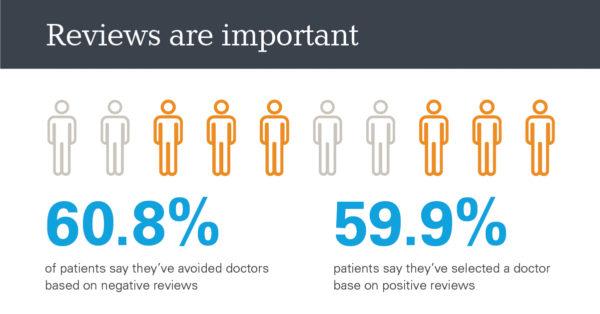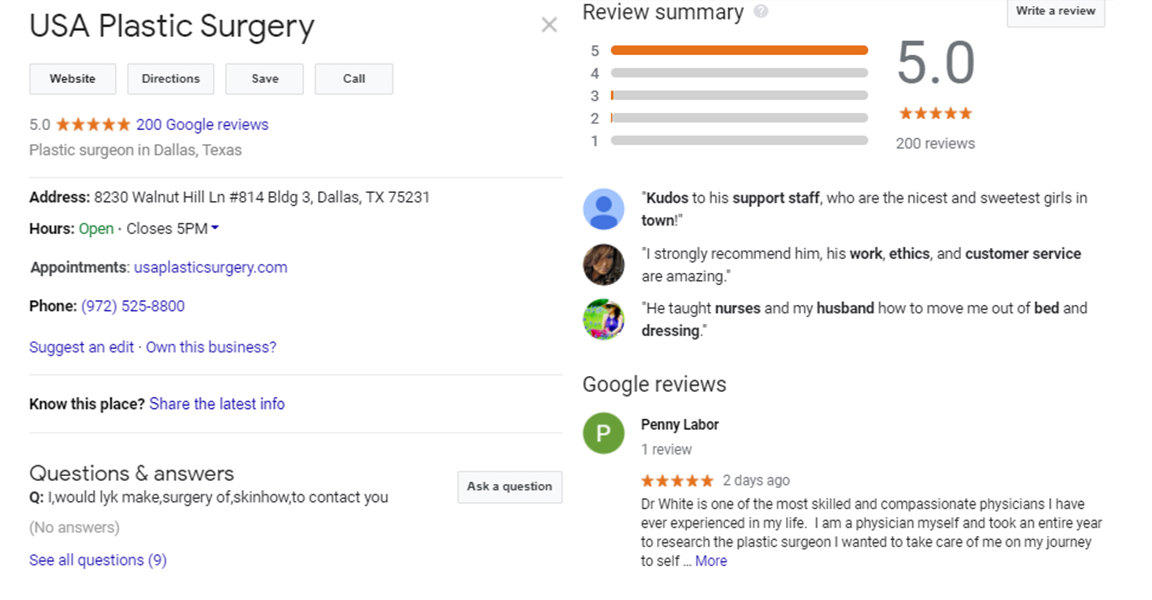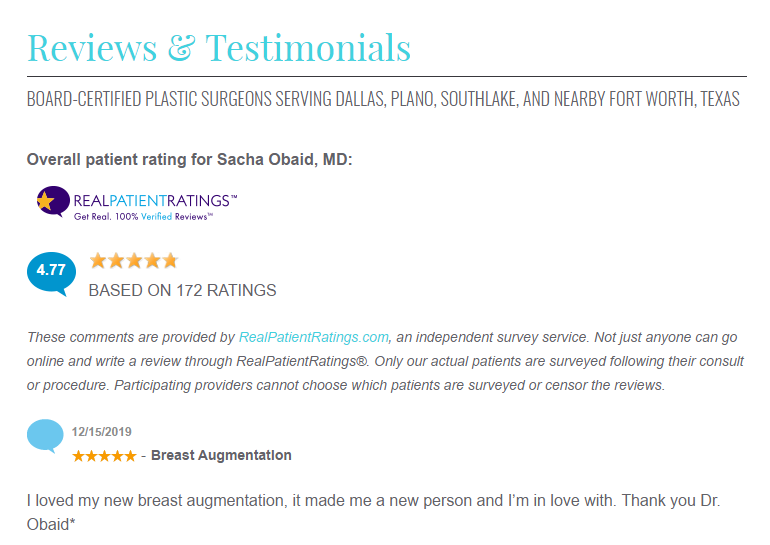What does 2021 have in store for plastic surgeons? With elective surgeries still suspended in some states, and many patients opting to postpone elective surgeries due to coronavirus, it’s hard to say. What we do know is that the competitive landscape is likely to remain white-hot.
As the market corrects and people begin feeling comfortable enough to go out and schedule the surgeries they want or need, but deferred in 2020 due to COVID, we can only assume that the level of competition will increase. After all, plastic surgery was one of many healthcare sectors hit especially hard by the COVID-19 outbreak. On the road to recovery and restabilizing the plastic surgery market, every lead, consultation, appointment, and surgery counts.
Which makes digital reputation and online reviews all the more important.
Why Your Digital Reputation Matters (And What You Can Do To Improve It)
Elective or not, surgery is serious business. It’s a major life event. As such, people want to know that you’re the best damn plastic surgeon in your city. They want to know that you’re deeply experienced and respected—that you’ve performed thousands of butt lifts, tummy tucks, or whatever your specialty might be.
So they read reviews online—lots of them—nearly without fail. According to a study published by NRC Health, “92.4% of consumers use online reviews to guide most of their ordinary purchasing decisions.” For many people seeking out plastic surgeons, reading online reviews is step one.
 Here are a few other eye-openers from that same study:
Here are a few other eye-openers from that same study:
- 34% of patients consider a doctor’s online reputation to be “very important”
- Nearly 60% of patients have chosen a doctor after reading positive reviews online
- More than 60% of patients have avoided a doctor due to their negative reviews
Yet, generating online reviews doesn’t necessarily happen in and of itself, nor does your broader digital reputation. If you think you can sit back and wait for patients to leave reviews organically, you might be waiting a long time to see any kind of significant gain. In fact, failing to manage your digital reputation might allow negative reviews to dominate your presence (happy patients aren’t as motivated to write reviews, it turns out).
It helps to first understand where healthcare consumers go to read your reviews. Here are a few important online review channels to be aware of:
- Plastic surgery review sites
- Your website (embedded reviews, testimonials, etc.)
- Your listings on the healthcare networks and insurance groups you’re part of
- Google Maps and Google Search listings
- Yelp and Facebook Business
With these fundamentals in mind, here are a few tips on how to both generate more reviews and shore up your digital reputation across your website and other important channels—to make sure your digital reputation is never the reason that potential patients turn away.
Start with Your Patient Experience
You may be the best plastic surgeon in the world, but it won’t matter much if you’re providing a poor patient experience. What we’ve found is that even highly reputable plastic surgery clinics that think they’re doing a great job are still creating headaches for their patients, which can lead to poor reviews.
- Have you audited your most common patient journeys from start to finish?
- Are you investing in tools, technology, and staff development that saves patients time?
- Are you making it easy to set up appointments online, reschedule existing engagements, or exchange messages with medical staff?
While “improving the patient experience” can seem very pie-in-the-sky, it’s so crucial to generating positive patient reviews. Here’s Dr. David B. Sarwer, quoted in an American Society of Plastic Surgeons press release:
“Establishing a strong, compassionate professional relationship at the onset will likely increase patient satisfaction rates and also provide an important foundation of support if an undesired outcome occurs.”
Manage Your Google My Business (GMB) and Other Business Listings
Google is the top place people go for information. Perform a search for anything these days, either using search, maps, or otherwise, and you’ll see reviews popping up everywhere. This is by design: Google very much wants its reviews to be threaded throughout all of its online properties.
To allow people to leave Google reviews for your business, you need to set up your GMB listing. Here’s how to do that (for each of your separate locations!):
- Go to Google My Business and register.
- Complete the verification process for each of your locations (this can take a couple of weeks).
- Optimize as much of your GMB listing as possible, including the accurate name, address, and phone (NAP), business categories, photographs, and so on.
 After registering, you’ll notice a ton of different profile settings you can optimize. Once your GMB listing is established, it’s important to engage with it weekly, if not daily. That means posting updates, new photos, special offers, and other important information. Make sure to respond to any questions that people have left, too. And take time to respond to both good and bad reviews!
After registering, you’ll notice a ton of different profile settings you can optimize. Once your GMB listing is established, it’s important to engage with it weekly, if not daily. That means posting updates, new photos, special offers, and other important information. Make sure to respond to any questions that people have left, too. And take time to respond to both good and bad reviews!
Concerning the latter, have a plan in place for how to address negative reviews. We’ve found that transparency, honesty, and a sincere effort to make things right can go a long way. While you might not be able to change the attitude of a past patient, you might be able to demonstrate a commitment to doing things the right way to prospective ones.
Finally, keep in mind that GMB isn’t the only listing channel that’s relevant for plastic surgeons. RealPatientRatings, for example, is a robust review site where all reviews are vetted for authenticity (no fakes). Similarly, RealSelf provides a searchable database of reviews for plastic and cosmetic surgeons. Just as you would on GMB, it’s important to establish and optimize your reputation on these sites, too.
Give Your Patients a Place to Share Feedback or Complaints
One of the common issues we find with our healthcare clients is that most of their patients don’t know how to leave reviews. Many plastic surgeons are burying links to their review sites or leaving it up to patients to find listings using a search engine.
Instead, make it clear that your doors are open—that your practice makes every avenue for patient feedback open and transparent. This might look like links to leave a Google Review embedded throughout your email campaigns and transactional communications. If patients don’t want to leave online reviews, give them ways to contact you directly in prominent places on your website (phone number, email address, or online feedback form).
Of course, when you do receive complaints—whether they be via phone, email, online, or in-person—it’s so important to make sure your patients feel heard and understood. Addressing their initial complaint is the best way to prevent negative digital reviews in the future. When people feel unheard, they are more inclined to take action to feel heard—like leaving public reviews.
Develop a Review Encouragement Program
Embedding links to leave reviews in your email communications is one thing. Formalizing a practice-wide process for regularly soliciting reviews is wholly another. Here are a few strategies to generate patient reviews regularly:
- Identify points of the patient journey where you can ask for reviews or testimonials. We mentioned transactional emails or automated messaging sent after an appointment. The point is to audit the journey, map it out, and specifically pinpoint those “triggers” in which your staff or systems ought to ask for a review.
- Normalize the act of asking for reviews. This will require some staff training, in which you provide employees with the how and when they should ask for reviews on the phone. Give them written scripts for how to do so. And when your staff is mentioned in reviews for jobs well done, be sure to acknowledge it and reward them!
- Automate the process. You can invest in tools like BirdEye to automatically solicit reviews via email, SMS, or even snail mail (actually, you’ll find that BirdEye does a lot more than that). The more you can personalize this messaging after procedures, for example, the better. However, these reputation management tools provide a great way to bolster, monitor, and improve your digital reputation on an ongoing basis.
Feature Patient Testimonials and Reviews on Your Website
There are your online reviews on Google and other sites, and then there are your testimonials directly from patients. Typically, the latter are longer quotes or even short videos that feature real patients sharing their experiences. It’s important to feature both reviews and testimonials on your site. Think:
- Build a library of stylized pull quotes, including the patient’s photograph, name, and surgery type, that can be used throughout your site.
- Invest in video testimonials and one-on-one post-op conversations between patients and their physicians. Videos can go a long way in humanizing the experience and allaying another prospective patient’s fears.
- Build longer-form patient stories that are rich with photos, quotes from both the patient and surgeon, and include other engaging digital elements.

Why? Your website is very much part of your digital reputation. It’s where people go to assess your brand and medical credentials. This is your opportunity to feature reviews, testimonials, and patient stories. Create a dedicated testimonial section, for one. And add testimonials to pages where leads go for information, such as dedicated pages for specific procedures or surgeon bios—places where the context of the testimonial aligns with the messaging on the page.
Create a Strong and Compelling About Us Page
This is one of the most overlooked parts of a plastic surgeon’s digital reputation. Your About Us page is often one of the first stops for website visitors. They want to get a feel for your practice and experience. They want to put faces to names. All of this creates an opportunity to be creative, interesting, and compelling.
Storytelling is a great way to do so. Only, with a small caveat. The art of the About Us page is telling your story—talking about yourself—in a way that creates value for what your patients want. You’d be surprised at just how many About Us pages start with the word “we.” Instead, reframe your story through the lens of what your patients want to see. How does your interesting background satisfy their plastic surgery needs?

The same goes for your mission and values statements. Rather than writing the same generic statements you find on every plastic surgeon’s website, center your mission and value statements around what your patient needs.
Finally, showcase your staff and staff experience, including updated photos. How can you present your surgeons and staff members in a way that exudes the commitment to friendly customer service you operate with every day? This is another opportunity to link out to a dedicated page for each surgeon. These surgeon pages are a chance to show surgeons’ credentials, experience, accomplishments, testimonials, etc.
In Closing: Digital Reputation is Earned, Not Bought
It can be tempting for companies of all kinds to find shortcuts to building their digital reputation. For whatever reason, this is especially true in healthcare. Some plastic surgeons will pay people to leave reviews even if they were never a patient. Others will even create dummy accounts and leave reviews themselves.
This is a NO-NO that will hurt your reputation in the long run.
As it turns out, there’s a healthy amount of skepticism around the validity of reviews, specifically in the world of plastic surgery. Even the reviews have a digital reputation! A study from Northwestern, for example, found that many of the reviews it looked at were from non-patients. Overall, the reviews were quite polarized—overwhelmingly negative, or overwhelmingly positive—making it difficult for real patients to make decisions based on these reviews.
In another study cited by ASPS, close to 40% of reviews “were written by patients who did not actually undergo breast augmentation performed by the surgeon they were reviewing.” It’s hard to trust a review about plastic surgery if it’s written by a person who never had the surgery!
The point is: managing digital reputation is nuanced. It requires constant vigilance in what has become a sort of digital wild west. The first step is to shore up the fundamentals listed above. If you do these things consistently, genuine reviews will come—and they’ll help you continue attracting patients to your practice.

